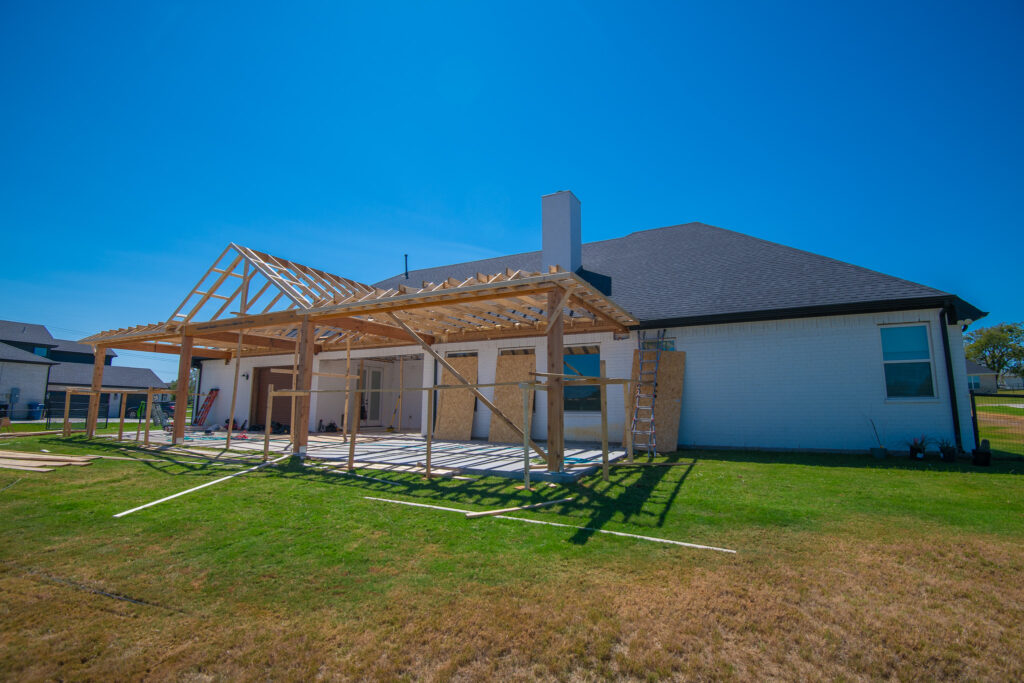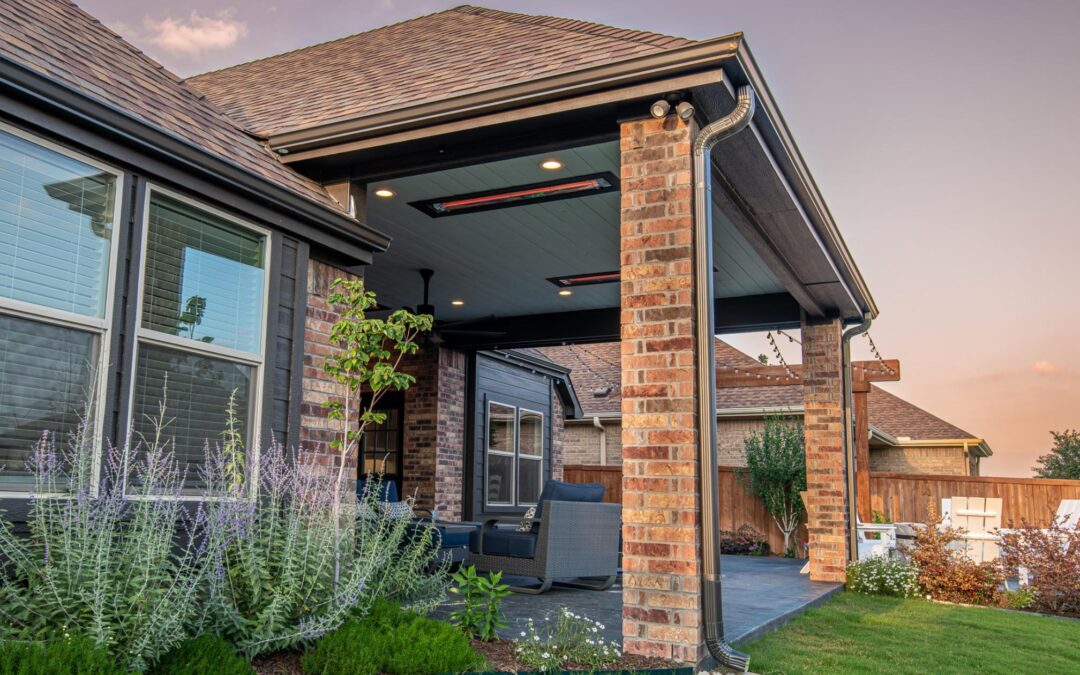In a hurry? Here’s a TL;DR (Too long; didn’t read): Gable roofs feature two sloping sides forming a triangular peak—they’re simpler, more economical. Hip roofs slope down on all sides, creating a self‑bracing, wind‑resistant structure with superior drainage and curb appeal, though they often cost more. The choice depends on your balance of budget, aesthetics, durability, and desired attic or ventilation space, with hip roofs favored in storm‑prone Texas.

What’s the Point of a Roof, Anyway?
At its core, your home’s roof serves as the frontline defense against the elements. Whether you’re bracing for a classic Texas thunderstorm, relentless summer sun, or the occasional cold snap, your roof keeps you—and everything beneath it—safe and dry. From unpredictable hail to stubborn wind gusts, a well-designed roof shields your entire home and ensures you won’t be mopping up leaks after every rain. In short, it’s the unsung hero standing guard over your investment, day in and day out. Choosing the right patio design can significantly affect the look and functionality of your outdoor space. The roof style can enhance or subtract from the overall appeal of your area. The two most popular roofing styles for Texas patios are hip roofs and gable roofs.
A gable roof is a sloped, triangular shape on two sides, while a hip roof features slopes on all four sides that come together at the peak. These designs offer unique benefits and challenges, influencing factors like cost, maintenance, and buyer preferences. Understanding the differences between these two styles is essential for making an informed decision.
Trying to decide what’s right for your home? This article will explore gable and hip roofs in-depth, examining their features, maintenance requirements, and cost considerations to help you select the perfect roof for your outdoor space. As a bonus, we’ve included photos of some of our favorite Hip and Gable projects below for inspiration!
When you’re ready to chat about building a patio, Texas Direct would love to talk!
What is a Gable Roof?
Gable roofs are a popular roof style characterized by two sloping sides that come together at a peak, forming the shape of an upside-down “V.” This design creates triangular extensions at each end, known as gables. A staple in Texas architectural styles, the gable roof has actually existed since colonial times in the 1600s.

Variations of Gable Roofs:
- Open Gable: Basic, unboxed ends.
- Boxed Gable: Features a triangular extension capped with siding.
- Cross-Gabled: Intersecting rooflines with their own gable.
- Gambrel: It resembles a barn with two different slopes on each side.
- Jerkinhead: Blends gable and hip styles, cutting off the gable peak to provide more excellent stability.
- Dutch Gable: A small gable roof placed atop a traditional hip roof for aesthetics and additional attic space.
Others use a combination of both roof types to create unique roof designs, allowing for even greater flexibility in appearance and function. This blending of styles can offer the charm of a gable with the wind resistance of a hip, or simply create a focal point for your outdoor space.
Gable roofs, constructed with trusses that align parallel to the roof’s slope, can be vulnerable to heavy winds. This susceptibility necessitates end bracing to bolster stability and ensure the longevity of the roof structure. When Texas Direct builds them, we account for this.
Often chosen for their simple design and aesthetic appeal, gable roofs remain popular due to their effective water shedding, high ceilings, and potential for attic space.
What is a Hip Roof?
A hip roof is a distinct architectural feature marked by its gentle pyramid shape. At least three sides slope downwards to the walls, typically with a subtle pitch. This design ensures no vertical ends are present. One of the primary functional advantages of a hip roof is its ability to channel heavy rain effectively, with slopes on all sides contributing to efficient drainage and excellent resistance against leaks and water damage.
Variations of Hip Roofs
Just as gable roofs showcase several creative spins, hip roofs offer their own lineup of design twists—each bringing unique style and structural perks to Texas patios and homes.
- Pavilion (or Pyramid) Hip Roof: This design tops a square structure with four equal slopes meeting at a single, sharp point, forming a pyramid shape. Think of gazebos or pavilion-style patios—clean, symmetrical, and perfect for showing off in the backyard.
- Mansard Roof: Popularized by French architecture, a mansard is essentially a hip roof with two different slopes on each side—the lower section much steeper for extra living or attic space. It delivers a stately look and practical upper-level headroom.
- Tented Roof: Often seen on octagonal or polygonal buildings, tented hip roofs feature steeper slopes that rise dramatically to a central peak—reminiscent of a church steeple or a grand historic estate.
- Dutch Gable Roof: This hybrid combines a hip roof with a small gable perched at the peak. Not only does it boost curb appeal, but it also allows for extra windows or attic ventilation—great for those who want a blend of style and function.
- Half-Hip (Jerkinhead) Roof: Sometimes called a clipped gable, this approach trims off the point of the gable, replacing it with a short, sloping hip. It offers improved wind resistance and a charming Old-World look, which is ideal for Texas homes seeking character and sturdiness.
These options allow homeowners to tailor their roof design to both practical needs and personal aesthetic—whether you prefer classic symmetry or a modern twist on tradition.
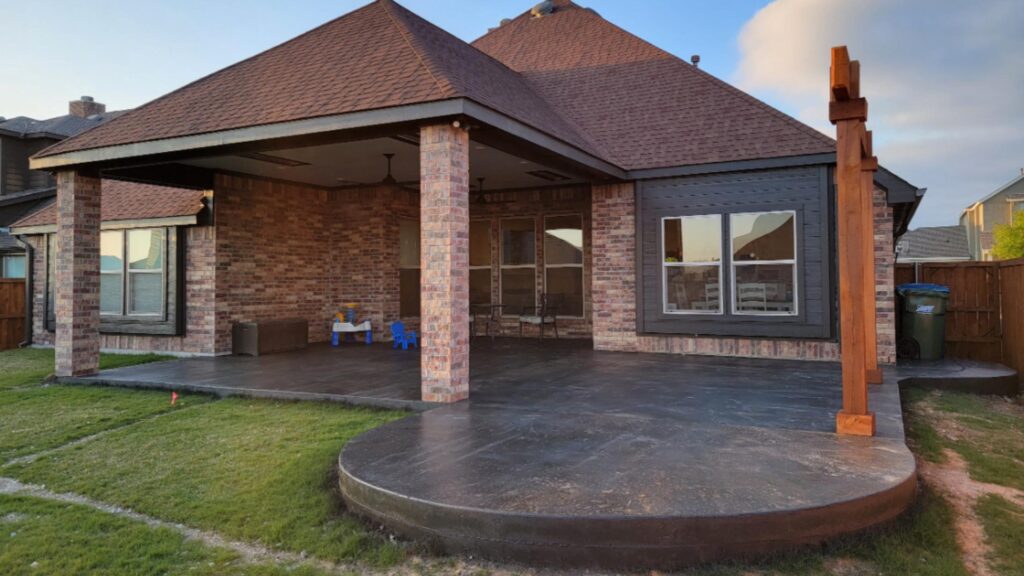
Hip roofs in Texas are well-loved for their aesthetic appeal and structural stability, making them a common choice for both residential and commercial buildings. However, the construction complexity of hip roof construction means they demand more materials and higher-level carpentry skills compared to more basic roof types like gable roofs. This complexity can result in increased costs. We’ve designed and completed many of these, and can ensure yours lasts as long as your home.
One significant merit of the hip roof design is its performance in storm-prone regions like Texas. Thanks to their shape, hip roofs can withstand strong winds better than many other styles, offering a robust defense against the elements. This quality contributes extensively to the popularity of hip roofs in areas frequently experiencing heavy winds.
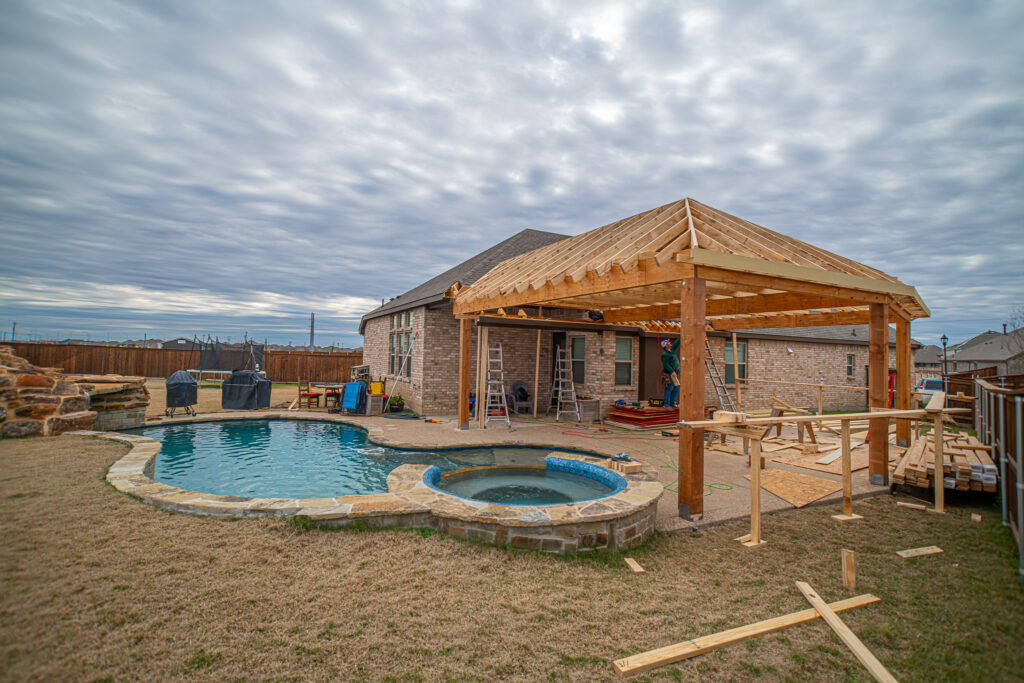
Main Differences Between Gable and Hip Roofs
When considering the style of roof you’d like, hip and gable roofs are two popular choices due to their distinctive characteristics and benefits. A hip roof is renowned for its symmetrical shape, with all sides sloping towards the walls without leaving any vertical ends. This design provides a sophisticated aesthetic appeal and a structural advantage in terms of stability and weather resistance. The inward slope is particularly useful in snowy areas, as it enables snow to slide off effortlessly, minimizing the likelihood of water damage.
In contrast, gable roofs possess a triangular shape that offers a simple yet classic design. Their construction requires less complexity and fewer materials, which decreases the overall cost compared to hip roofs. This can make gable roofs more budget-friendly for those looking to build or renovate a home. While their peaked structure allows for excellent rain and snow drainage, they are not as adept at handling high winds or creating additional attic space as hip roofs.
The choice between hip and gable roofs often hinges on various factors, including budget, aesthetic preference, and environmental considerations such as local weather patterns. Homeowners might favor hip roofs for their added living space possibilities within the roof’s structure and their durability in the face of extreme weather, while gable roofs are chosen for their straightforward design and cost-efficiency.
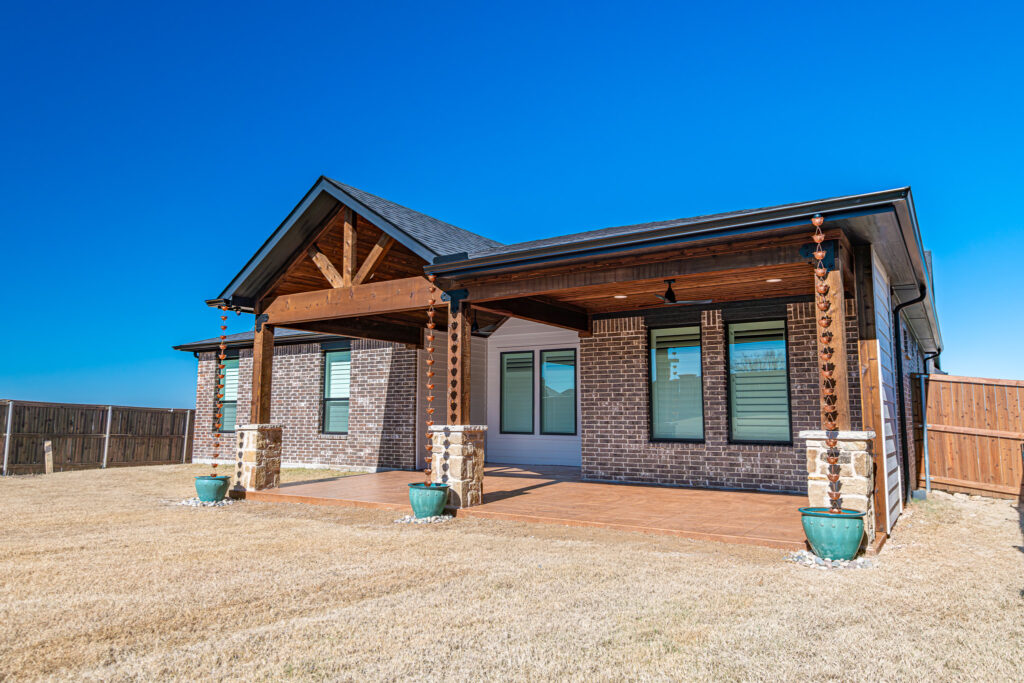
Cost Considerations
Economic factors play a significant role when selecting the type of roof for a building project. Hip roofs are, on average, more costly than gable roofs due to the complexity of their design and the increased quantity of materials necessary for their construction. The price range for a hip roof typically falls between $20,000 and $60,000, encompassing the framing materials and installation labor costs.
Gable roofs, with their more simplistic style, are generally less expensive, ranging in cost from $13,000 to $48,000. The price per square foot is notably lower, which makes gable roofs a more economical option for many homeowners. The difference in construction costs is considerable, with a hip roof potentially costing between 35 to 40 percent more than a gable roof.
More Cost Data
When considering the construction of a hip and ridge patio or a gable patio, it’s crucial to factor in the cost implications of each roof style. Hip roofs are recognized for their complex design and are typically 35 to 40 percent more costly than simpler gable roofs. This complexity is due to the increased framing materials and the labor required for their intricate construction.
On average, the cost per square foot for hip roofs ranges from $8 to $12, while gable roofs are more budget-friendly, at $4 to $6 per square foot. For a hip roof, you might expect the overall expenditure, including building and shingling, to be between $33,600 and $67,200, a figure that underscores the significant price disparity when compared to a gable roof, which may cost between $24,000 and $48,000.
Various factors affect a hip roof’s total cost, such as the roof’s slope, the materials selected, the pitch, and the overall roof area. These elements need careful consideration as they can considerably sway the final pricing. It’s important to note that while a gable patio might be less expensive upfront, the aesthetic appeal and potentially better resistance to solid winds offered by a hip roof might justify its higher cost for some homeowners.

Gable Roof Maintenance versus Hip Roof Maintenance
Comparing gable and hip roofs, the clear distinction emerges in the maintenance requirements due to their design structures. Hip roofs typically require more meticulous maintenance because of their additional seams, which are more likely to leak, primarily if not installed immaculately. The hip roof’s complex design is not just an architectural choice but also a consideration for homeowners as it can manifest in more frequent and perhaps more onerous maintenance demands.
Conversely, gable roofs, with their simple design and lesser number of seams, generally face fewer leak-related issues. This simplicity not only translates to a lower propensity for complications but also eases the burden of upkeep. For gable roofs, lesser maintenance needs are a notable advantage, contributing to their popularity among homeowners.
Incorporating these considerations, it’s essential to recognize that the larger surface area of the hip roof — which extends by approximately 80 square feet for a similarly sized house — translates to more material that requires maintenance, inevitably affecting both the effort and cost associated with upkeep. When planning roof maintenance, a careful assessment of potential issues peculiar to each roof type must be made, understanding that hip roofs may demand more attention to maintain their integrity and weather resistance.
Buyer Preferences for Roof Styles
When choosing a roof style, various factors influence homeowner preference. Texas homes favor gable roofs because of their straightforward triangular shape, efficiency, and generally pleasing aesthetics. They are praised for being more cost-effective, reducing construction times, and offering excellent ventilation, which can also translate into potential attic space — a valuable asset for many homeowners.
Hip roofs, while providing an elevated curb appeal with their sophisticated appearance, are also appreciated for their structural robustness, particularly in regions prone to high winds and hurricanes. This self-bracing design contributes to their ability to fare well in extreme conditions. However, despite their reduced maintenance needs in certain aspects, such as debris and leaf accumulation prevention due to their slopes, the higher construction costs and increased risk of leaks may be seen as drawbacks.
In essence, buyer preferences for roof styles often balance cost, aesthetic appeal, maintenance requirements, and resilience to regional weather conditions. Gable roofs offer a simple, cost-effective solution with ample attic space and easy maintenance, while hip roofs, with their strong wind resistance and heightened visual appeal, stand out as a robust architectural feature, albeit with potentially higher upfront costs and maintenance considerations.
Want more photos and videos? Click here!
Want to meet and speak with our Outdoor Living company for a quote? Click here!
